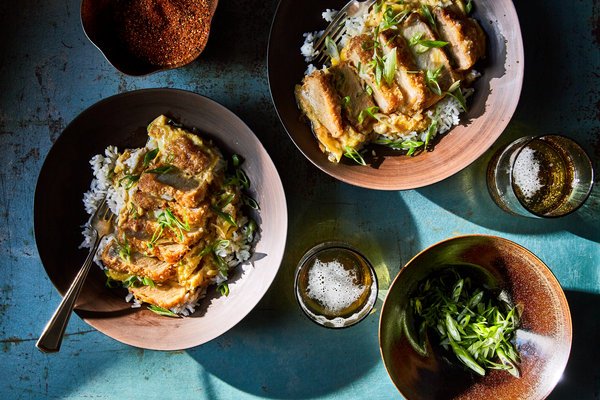Like so much of the exuberant food imagery that I’m drawn to in anime, the katsudon in “Yuri!!! on Ice,” a series about a competitive figure skater in his early 20s, appeared as a less detailed but somehow more vivid version of itself. A Japanese rice bowl capped with golden slices of pork cutlet, held together with barely cooked eggs and translucent onions — textures exaggerated, colors saturated, aromas made visible — occasionally twinkling in soft focus, as if seen through a Vaseline-greased lens. “Is this what God eats?!” one character asked another, trembling, cheeks flushed, eyes wide with the shock of its pleasure. What I love about food in anime is the truth in its hyperbole.
《冰上的尤里》(Yuri!!! on Ice)讲述的是一个20岁出头的竞技花样滑冰选手的故事。和我喜欢的日本动漫里很多绚烂夺目的美食画面一样,这部动画片里的猪排饭看上去没那么精致,却异常生动。日式的碗里盛着米饭,上面盖着金黄的猪排,搭配几乎全生的鸡蛋和半透明的洋葱——食材口感被放大,色彩饱满,香味似乎能看得见。柔焦镜头下的它们偶尔还会闪烁一下,像是透过擦了凡士林的镜头看到的情景。“这是神灵吃的吗?!”片中一个声音颤抖、脸颊绯红、因为看到美食而惊喜地睁大眼睛的角色问另一个人。对于日本动漫里的美食,我喜欢的正是从它们的夸张里表现出来的真实。
I meant to watch just one episode of the 12-part first season when it came out last fall on some streaming sites. My friend Whitney had told me I’d love it, but I didn’t realize how much: I stayed up and watched them all, more and more charmed and hungry. At first, Yuri is anxious. And he makes mistakes when he’s anxious, and he tortures himself over those mistakes. When he’s celebrating a win, or stuck in a professional slump, he finds comfort in katsudon. “Yuri” devotees from all over the world were quick to recreate his favorite dish at home, posting photos of their versions online like ephemeral fan art. They styled the dishes faithfully, with an addition of peas (at the fictional hot-springs inn that Yuri’s parents run in Kyushu, the dish is served with peas). By the time I finished the series, I wanted to do the same, so I asked Whitney to come over for dinner.
去年秋天,当这部动画片第一季12集登陆一些流播放网站时,我本来只打算看一集。看之前,朋友惠特尼(Whitney)说我会喜欢的,但我没想到自己会这么喜欢:我熬夜把12集全看完了,越看越着迷,越看越饿。起初,尤里感到焦虑。他一焦虑就会犯错,然后又因为这些错误折磨自己。庆祝胜利或处在职业生涯的低潮时,他会在猪排饭中找到安慰。世界各地的“尤里”迷们很快便开始在自己家里制作他最爱的这道美食,并把各自作品的照片发布到网上,就像转瞬即逝的粉丝作品(fan art,指动漫、电子游戏、电影等作品的爱好者根据原作中的角色或内容创作的艺术品——译注)一样。他们忠实地设计,还会加上豌豆(在故事里,尤里的父母在九州经营的温泉旅店供应的猪排饭里有豌豆)。看完这部动画片时,我也想这么做。于是,我请惠特尼过来吃饭。

The foundation of the dish is tonkatsu, a deep-fried breaded pork cutlet that became popular in Japan by the early 20th century. Tonkatsu may have started out as an imitation of European-style cutlets — thin, flimsy slices of veal and lamb, sautéed in butter and served with a fork and a knife — but Japanese cooks soon owned it, revised it and deviated from the European recipes to develop their own style. By the 1920s, restaurants in Tokyo specialized in thick, evenly crisp cutlets, made from pork and deep-fried, often in lard. They served these in slices, so people could grasp them with chopsticks. Tonkatsu is now omnipresent, under heat lamps and behind glass at convenience stores, and on boards with shredded cabbage at high-end restaurants. In a Japanese home, it wouldn’t be unusual to have one or two in the fridge, like a leftover piece of fried chicken.
这道美食的基础是20世纪初在日本流行起来的油炸裹了面包屑的猪排。炸猪排起初可能是模仿欧式肉排——将牛肉或羊肉切成薄片,用黄油嫩煎,搭配刀叉食用——但很快,日本厨师便掌握了其中的技巧,并对其进行了改进,从欧洲的做法中发展出了自己的风格。到上世纪20年代,东京有不少餐厅主打厚实但每一处都酥脆可口的猪排。它们通常是用猪油炸制而成。厨师会将猪排切成块,方便人们用筷子食用。现在,加热灯下,便利店的玻璃门后、高档餐厅里,炸猪排随处可见。在日本家庭的冰箱里发现一两块炸猪排一点都不奇怪,就像吃剩的炸鸡块一样。
Katsudon is particularly helpful if you need to revive one of those cold, just-starting-to-sog cutlets, stretching it into a cheap, delicious meal. The simmering broth soaks into the breading, turning it juicy, drenching it with umami. But make it with a fresh, warm cutlet, and it’s even more rewarding. In his recipe for the dish in “Japanese Soul Cooking,” the chef Tadashi Ono suggested using pork shoulder or loin, so I bought some of both. After a generous salt and pepper, I dipped the cutlets in flour, egg and panko, the Japanese bread crumbs, and fried them in a wide cast-iron pan.
如果想让一块冰冷的、刚刚开始冻透的肉排恢复生机,把它变成一顿好吃不贵的饭,猪排饭特别有用。慢炖的高汤渗入面包屑,让它变得多汁,鲜味四溢。但如果用新鲜的常温猪排做会更美味。在《日本灵魂烹饪》(Japanese Soul Cooking)的猪排饭食谱里,小野规(Tadashi Ono,音)大厨建议用猪肩胛或里脊肉,因此我两样各买了一点。在涂抹了足量的盐和胡椒粉后,我把肉排在加了面粉和面包屑的鸡蛋液中浸了一下,再放入宽口铸铁平底锅里煎。
With a plastic mandoline, I shaved half an onion and put it in another pan with dashi, soy sauce and mirin, simmering it until the onion went floppy and translucent. I added ginger, because in her cookbook “Japanese Farm Food,” Nancy Singleton Hachisu writes about adding a little julienned raw ginger to her broth, before sliding the cutlets into the pan. While Whitney opened some beers, I cracked eggs into a small bowl, broke them up with a fork and poured them over the breading. Within a few minutes, the egg was set at the edges of the pan and the rice was ready. I piled everything in bowls and scattered some scallion on top.
然后,我用塑料蔬果刨把半个洋葱刨成丝,放入另一个加了出汁(一种高汤——译注)、酱油和米酒的锅里煮,一直炖到洋葱变软呈半透明。我还加了点姜,因为南希·辛勒顿·莲(Nancy Singleton Hachisu)在《日本农家菜》(Japanese Farm Food)提到,在把肉排放进锅里之前,她在汤里加了生姜丝。在惠特尼开啤酒的时候,我把鸡蛋打进一个小碗里,用叉子搅散,再把蛋液倒在面包屑上面。几分钟后,蛋液在锅边凝固,米饭也熟了。我将它们盛入碗中,再在上面撒了一些葱花。
There’s always a gap between how the food you make looks in real life and how you thought it might look based on the pictures. I was prepared for it when the katsudon didn’t emit its own light and twinkle cartoonishly, when it didn’t look anything like its perfect, airbrushed, animated muse. But we both agreed, as we cleaned our bowls, that it was just right.
自己实际做出的饭菜的样子,和你根据图片想象它会呈现出来的样子之间总是有差距。新鲜出炉的猪排饭没有像动画片里那样闪烁、自带光芒,看上去一点也不像动画片里那种完美的、经过精心修饰的灵感源泉,我对此有所准备。不过,我们吃得干干净净,并一致认为非常不错。












